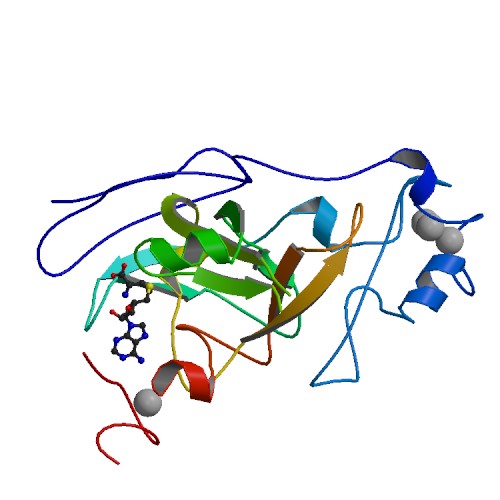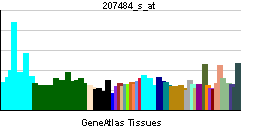EHMT2
| Euchromatic histone-lysine N-methyltransferase 2 | |||||||||||||
|---|---|---|---|---|---|---|---|---|---|---|---|---|---|
 PDB rendering based on 2o8j. | |||||||||||||
| |||||||||||||
| Identifiers | |||||||||||||
| Symbols | EHMT2 ; BAT8; C6orf30; FLJ35547; G9A; NG36; NG36/G9a | ||||||||||||
| External IDs | Template:OMIM5 Template:MGI HomoloGene: 48460 | ||||||||||||
| |||||||||||||
| RNA expression pattern | |||||||||||||
 | |||||||||||||
 | |||||||||||||
| More reference expression data | |||||||||||||
| Orthologs | |||||||||||||
| Template:GNF Ortholog box | |||||||||||||
| Species | Human | Mouse | |||||||||||
| Entrez | n/a | n/a | |||||||||||
| Ensembl | n/a | n/a | |||||||||||
| UniProt | n/a | n/a | |||||||||||
| RefSeq (mRNA) | n/a | n/a | |||||||||||
| RefSeq (protein) | n/a | n/a | |||||||||||
| Location (UCSC) | n/a | n/a | |||||||||||
| PubMed search | n/a | n/a | |||||||||||
Euchromatic histone-lysine N-methyltransferase 2, also known as EHMT2, is a human gene.[1]
A cluster of genes, BAT1-BAT5, has been localized in the vicinity of the genes for TNF alpha and TNF beta. This gene is found near this cluster; it was mapped near the gene for C2 within a 120-kb region that included a HSP70 gene pair. These genes are all within the human major histocompatibility complex class III region. This gene was thought to be two different genes, NG36 and G9a, adjacent to each other but a recent publication shows that there is only a single gene. The protein encoded by this gene is thought to be involved in intracellular protein-protein interaction. There are three alternatively spliced transcript variants of this gene but only two are fully described.[1]
References
Further reading
- Spies T, Bresnahan M, Strominger JL (1989). "Human major histocompatibility complex contains a minimum of 19 genes between the complement cluster and HLA-B". Proc. Natl. Acad. Sci. U.S.A. 86 (22): 8955–8. PMID 2813433.
- Milner CM, Campbell RD (1993). "The G9a gene in the human major histocompatibility complex encodes a novel protein containing ankyrin-like repeats". Biochem. J. 290 ( Pt 3): 811–8. PMID 8457211.
- Tachibana M, Sugimoto K, Fukushima T, Shinkai Y (2001). "Set domain-containing protein, G9a, is a novel lysine-preferring mammalian histone methyltransferase with hyperactivity and specific selectivity to lysines 9 and 27 of histone H3". J. Biol. Chem. 276 (27): 25309–17. doi:10.1074/jbc.M101914200. PMID 11316813.
- Brown SE, Campbell RD, Sanderson CM (2002). "Novel NG36/G9a gene products encoded within the human and mouse MHC class III regions". Mamm. Genome. 12 (12): 916–24. PMID 11707778.
- Ogawa H, Ishiguro K, Gaubatz S; et al. (2002). "A complex with chromatin modifiers that occupies E2F- and Myc-responsive genes in G0 cells". Science. 296 (5570): 1132–6. doi:10.1126/science.1069861. PMID 12004135.
- Tachibana M, Sugimoto K, Nozaki M; et al. (2002). "G9a histone methyltransferase plays a dominant role in euchromatic histone H3 lysine 9 methylation and is essential for early embryogenesis". Genes Dev. 16 (14): 1779–91. doi:10.1101/gad.989402. PMID 12130538.
- Strausberg RL, Feingold EA, Grouse LH; et al. (2003). "Generation and initial analysis of more than 15,000 full-length human and mouse cDNA sequences". Proc. Natl. Acad. Sci. U.S.A. 99 (26): 16899–903. doi:10.1073/pnas.242603899. PMID 12477932.
- Shi Y, Sawada J, Sui G; et al. (2003). "Coordinated histone modifications mediated by a CtBP co-repressor complex". Nature. 422 (6933): 735–8. doi:10.1038/nature01550. PMID 12700765.
- Xie T, Rowen L, Aguado B; et al. (2004). "Analysis of the gene-dense major histocompatibility complex class III region and its comparison to mouse". Genome Res. 13 (12): 2621–36. doi:10.1101/gr.1736803. PMID 14656967.
- Ota T, Suzuki Y, Nishikawa T; et al. (2004). "Complete sequencing and characterization of 21,243 full-length human cDNAs". Nat. Genet. 36 (1): 40–5. doi:10.1038/ng1285. PMID 14702039.
- Roopra A, Qazi R, Schoenike B; et al. (2005). "Localized domains of G9a-mediated histone methylation are required for silencing of neuronal genes". Mol. Cell. 14 (6): 727–38. doi:10.1016/j.molcel.2004.05.026. PMID 15200951.
- Nishio H, Walsh MJ (2004). "CCAAT displacement protein/cut homolog recruits G9a histone lysine methyltransferase to repress transcription". Proc. Natl. Acad. Sci. U.S.A. 101 (31): 11257–62. doi:10.1073/pnas.0401343101. PMID 15269344.
- Gerhard DS, Wagner L, Feingold EA; et al. (2004). "The status, quality, and expansion of the NIH full-length cDNA project: the Mammalian Gene Collection (MGC)". Genome Res. 14 (10B): 2121–7. doi:10.1101/gr.2596504. PMID 15489334.
- Collins RE, Tachibana M, Tamaru H; et al. (2005). "In vitro and in vivo analyses of a Phe/Tyr switch controlling product specificity of histone lysine methyltransferases". J. Biol. Chem. 280 (7): 5563–70. doi:10.1074/jbc.M410483200. PMID 15590646.
- Rual JF, Venkatesan K, Hao T; et al. (2005). "Towards a proteome-scale map of the human protein-protein interaction network". Nature. 437 (7062): 1173–8. doi:10.1038/nature04209. PMID 16189514.
- Duan Z, Zarebski A, Montoya-Durango D; et al. (2005). "Gfi1 coordinates epigenetic repression of p21Cip/WAF1 by recruitment of histone lysine methyltransferase G9a and histone deacetylase 1". Mol. Cell. Biol. 25 (23): 10338–51. doi:10.1128/MCB.25.23.10338-10351.2005. PMID 16287849.
- Kimura K, Wakamatsu A, Suzuki Y; et al. (2006). "Diversification of transcriptional modulation: large-scale identification and characterization of putative alternative promoters of human genes". Genome Res. 16 (1): 55–65. doi:10.1101/gr.4039406. PMID 16344560.
- Beausoleil SA, Villén J, Gerber SA; et al. (2006). "A probability-based approach for high-throughput protein phosphorylation analysis and site localization". Nat. Biotechnol. 24 (10): 1285–92. doi:10.1038/nbt1240. PMID 16964243.
- Reeves M, Murphy J, Greaves R; et al. (2006). "Autorepression of the human cytomegalovirus major immediate-early promoter/enhancer at late times of infection is mediated by the recruitment of chromatin remodeling enzymes by IE86". J. Virol. 80 (20): 9998–10009. doi:10.1128/JVI.01297-06. PMID 17005678.
- Estève PO, Chin HG, Smallwood A; et al. (2006). "Direct interaction between DNMT1 and G9a coordinates DNA and histone methylation during replication". Genes Dev. 20 (22): 3089–103. doi:10.1101/gad.1463706. PMID 17085482.
| This protein-related article is a stub. You can help Wikipedia by expanding it. |